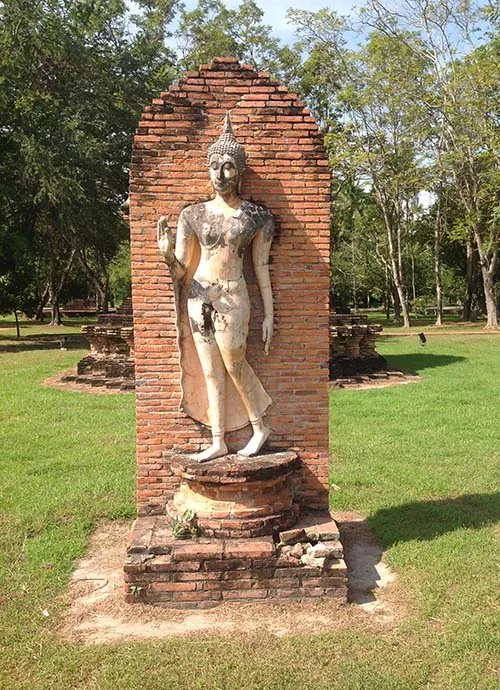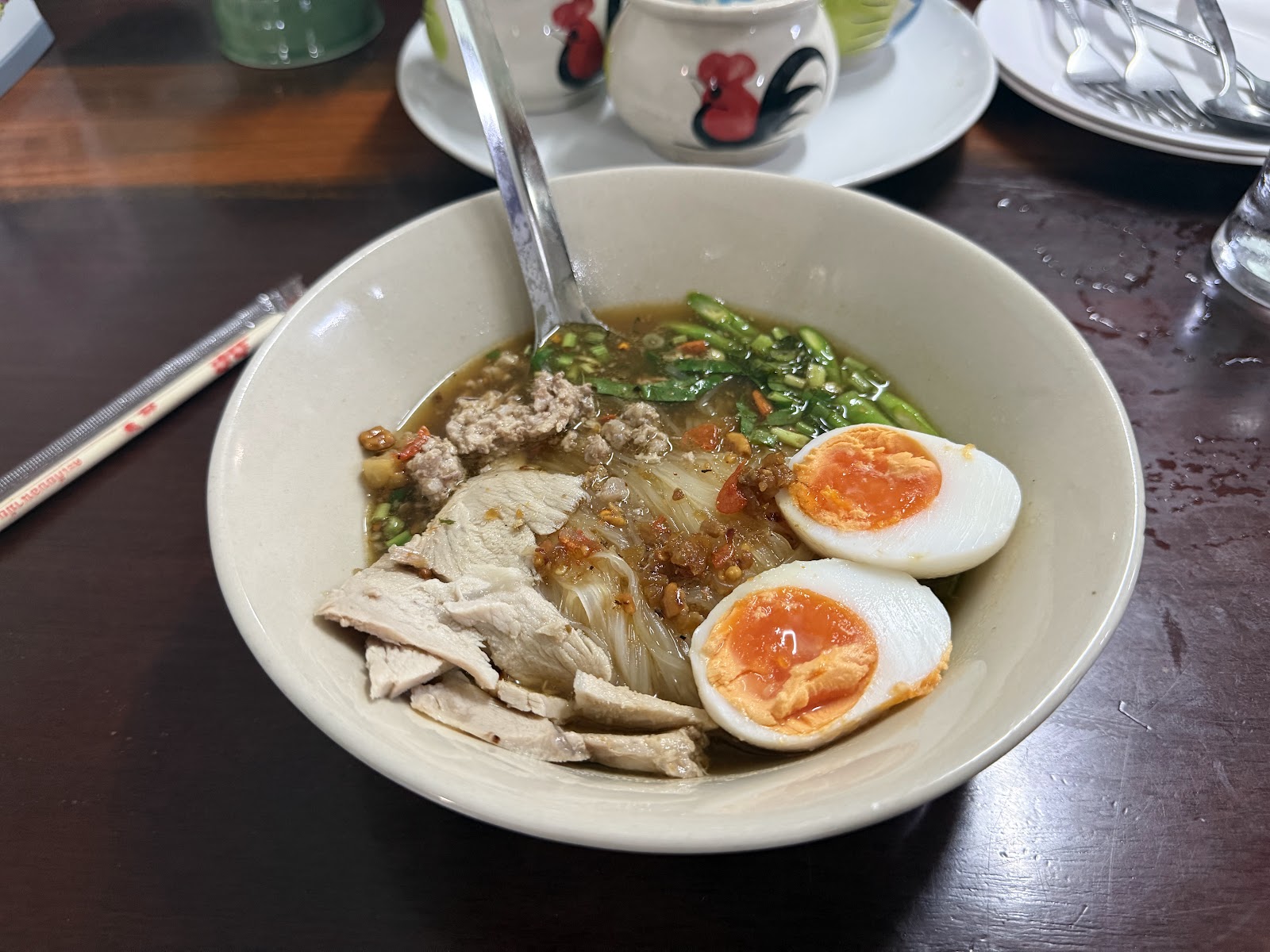6/8
We left Chiang Mai (wipes away tear) the morning of the 8th to drive to Lampang, home of the Thai Elephant Conservation Centre. This site is both a consistent trip highlight and a source of ethical complexity for our community—students and faculty alike. I do a really thorough exploration of these curiosities and challenges in this post, so read it if you’d like.
I’ll say this, in the 5 years I’ve been coming here, I’ve seen the Centre evolve its treatment of elephants. The hooks are used far less frequently and usually it’s the blunt end (not the pointy end) and the historical demonstration of elephant/Thai relationships no longer features the platform/harness that elephants would have worn when transporting nobility. It’s evident that this Centre wants to honor and protect its elephants. And they still need tourism dollars to feed and care for them.
From the internet: This elephant's skin is reflective of depigmentation, due to a variety of factors, including genetics, environment, and age. This lack of pigmentation can manifest as pink or light brown skin, often seen in Asian elephants. While some might be due to a genetic condition called leucism, others are simply normal variations within an elephant's natural skin pigmentation.

Cory petting an elephant

Mahoot bathing his elephant

Lawson was selected for the superbowl halftime balltoss show
As a reward, Lawson got an elephant feeding goodie bag
We ate lunch at a Century Plaza, where I had my first food fail of the trip. Wanted brothy noodles. Ended up with snot noodles. Like, full fledged snot noodles. I’ll eat most things. This one was so so so bland, but also snot-like. In keeping with the Arrested Development references, “watery, with a smack of snot.” I hope like…one person gets that reference.
Snot noodles
From there, we drove to Sukhothai and got settled into what is my personal favorite resort of the trip: Le Charme. We went on a run, had some pool time, had a tasty buffet dinner, and called it a night.
6/9
Another crowd favorite day. After a morning jog and breakfast at the resort, we loaded vans and set out for Sukhothai National Park, site of the historic capital of Thailand and surrounding areas (before nation borders were established). Given the number of historic structures and amount of space occupied by these features, the best way to tour them is by bike!!
Kept getting mistaken for a local. Check out that cheetah bike...
I give good history of Sukhothai in this post, but I’ll add some additional nuggets here, specifically related to types of architecture found in Sukhothai and types of Buddha figures.
FromChatGPT:
- Chedi (Stupa) Lotus Bud Shape: This elegant, bell-like structure with a pointed lotus-bud top is the defining symbol of Sukhothai’s chedi style. Its form represents purity and cosmic order. Central chedis at Wat Mahathat and Wat Saphan Hin follow this design.

Chedi
- Prang: Tower Structure: Originating from Khmer influence, prangs are tower-like spires often richly decorated. The prang at Wat Phra Phai Luang—formerly a Hindu shrine—is a great example.
- Mondop: Square Shrine with Tiered Roof: Mondops are standalone, square or cruciform structures with multi-tiered roofs. Notably, Wat Si Chum features a mondop encasing the massive Phra Achana Buddha

Mondop
- Bot (Ubosot) & Viharn:Bot (Ubosot): The sacred ordination hall, typically enclosed and marked by ceremonial sema stones. Viharn: The temple’s assembly or prayer hall, often housing principal Buddha images. These buildings form the heart of monastic rituals, like those at Wat Mahathat
- Sala: Open Pavilion: Sala are open-air pavilions used for resting, teaching, or gatherings. Scattered throughout temple grounds, they are practical yet elegantly simple.
- Prasat: Shrine Hall & Royal Emblem: A prasat is a richly ornamented shrine or temple hall, often used interchangeably with “viharn.” In Sukhothai, the term can also refer to square royal hall remnants such as Noen Prasat near Wat Mahathat, which was built with a lotus‑petal base.
Types of Buddhas:
- Seated Buddha (Meditation or Calling the Earth to Witness)
- Subduing Mara (often part of the seated pose)
- Position: Right hand touches the earth, as in seated position above.
- Meaning: Emphasizes the moment of overcoming temptation and attaining enlightenment.
- Position: Buddha is cross-legged (often in the lotus position), with the right hand touching the ground and the left resting in the lap.
- Meaning: Represents the moment of enlightenment when the Buddha called the earth to witness his triumph over Mara (temptation).
Seated Buddha
- Walking Buddha (unique to Sukhothai)
- Position: The Buddha takes a graceful step forward, with one hand raised in reassurance (abhaya mudra).
- Meaning: Symbolizes compassion in action, spreading the teachings, and spiritual progress.
- Unique Feature: This style was pioneered in Sukhothai and rarely found elsewhere in earlier Buddhist art.
- Reclining Buddha
- Position: The Buddha lies on his right side, head supported by his hand.
- Meaning: Represents the Buddha during his final illness, entering Parinirvana (the final passing into Nirvana).
Reclining Buddha in Wat Pha Sorn Kaew:
Photo credit: Cory
- Standing Buddha
- Position: Upright figure, sometimes with one hand raised in blessing or reassurance.
- Meaning: Varies: can express protection, calming of disputes, or teaching.
After that, we had free time, and folks took advantage of the elephant fountains in the pool. There was frisbee tossing and human letter making and much rejoicing. A large group went to a local market—if anyone wants wants to do a write up of the market experience, please send it to me and I’ll include it in this post.
Dinner at the hotel, and for me, an accidental super early evening (asleep by 9), which meant an accidental super early morning (4:30am), which is why the blog is now back up to date in real time :)
Off to Phetchabun!
Dinner at the hotel, and for me, an accidental super early evening (asleep by 9), which meant an accidental super early morning (4:30am), which is why the blog is now back up to date in real time :)
Off to Phetchabun!













No comments:
Post a Comment